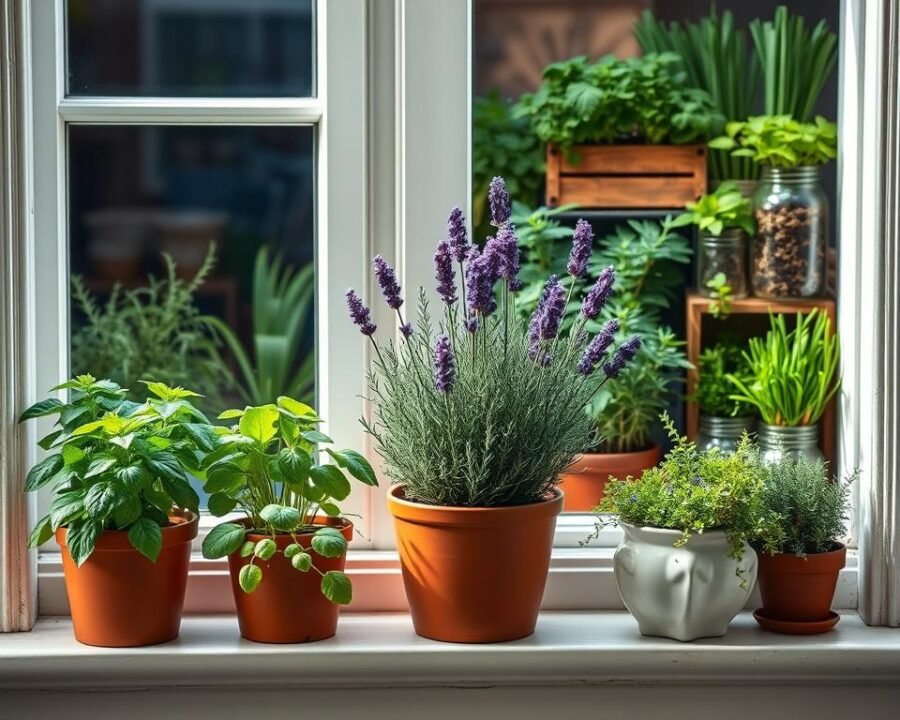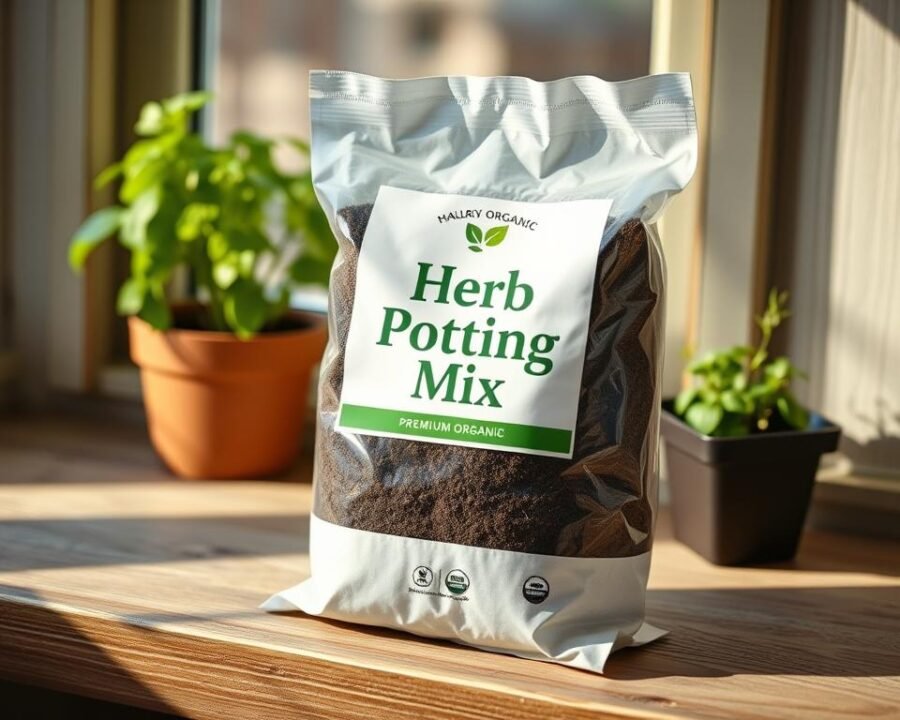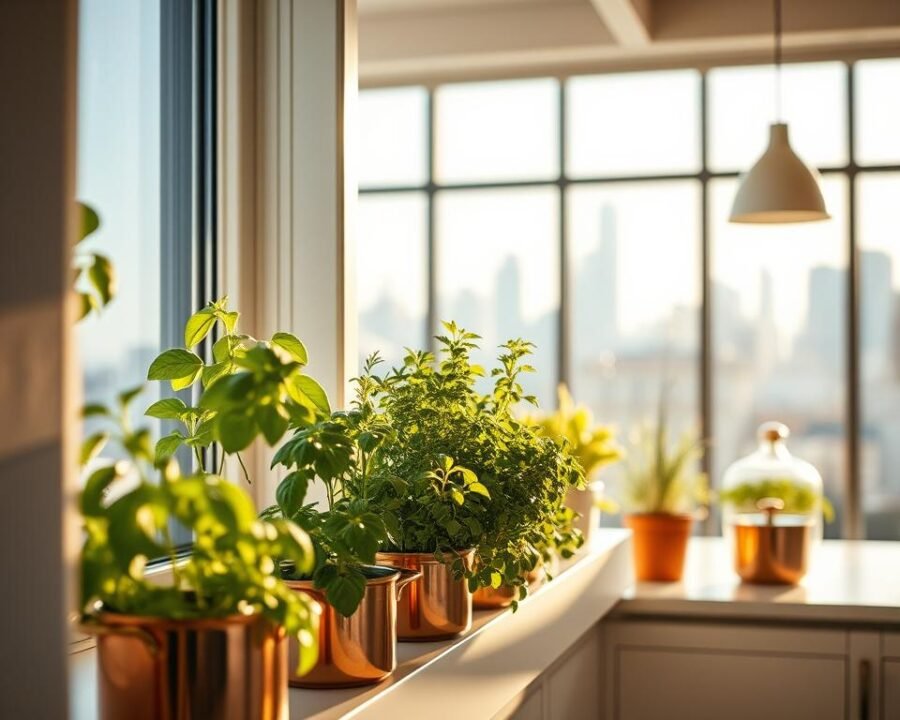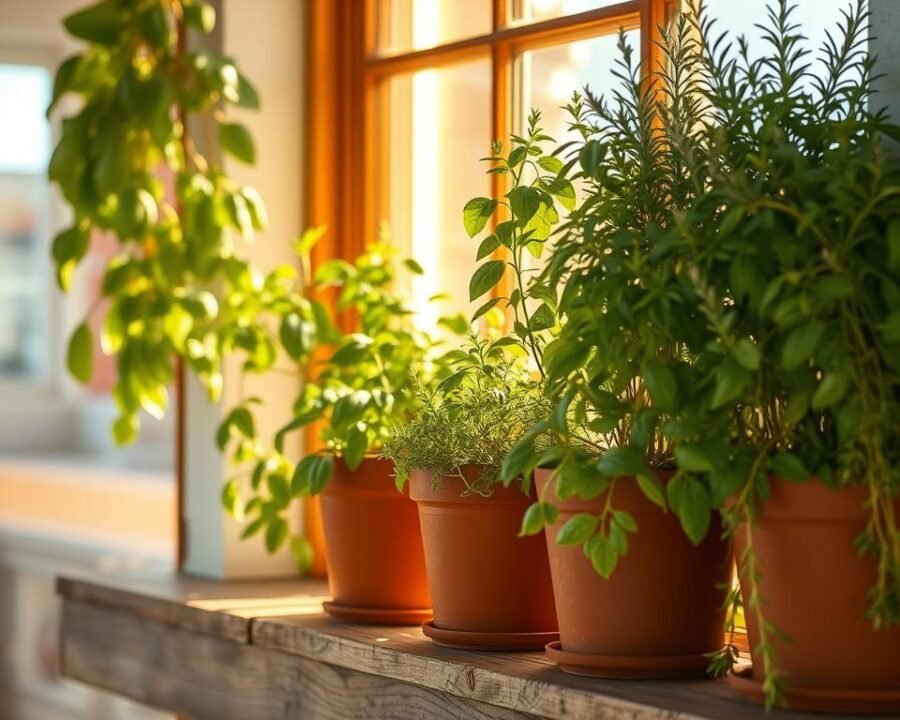There’s something magical about plucking fresh leaves right from your home. Whether you’re cooking or just enjoying the greenery, a small indoor setup brings joy and flavor to daily life. It’s not just about convenience—it’s about creating a little oasis.
Gordon M. shares, “Adds a lovely decorative item…functional and pretty.” His words capture the dual charm of these compact setups. They brighten spaces while offering fresh ingredients year-round, no backyard required.
Forget seasonal limitations. With the right choices, vibrant flavors thrive even in winter. Later, we’ll explore top picks for every skill level and space-saving tricks. Let’s dive in!
Key Takeaways
- Fresh flavors and decor combine in one simple setup.
- Compact designs fit even the smallest spaces.
- Year-round growth beats outdoor seasonal limits.
- Beginner-friendly options make starting easy.
- Reviews highlight both beauty and practicality.
Why a Windowsill Herb Garden Is Perfect for Your Home
Fresh, aromatic flavors transform meals when snipped straight from your countertop. Homegrown varieties pack a punch store-bought options can’t match. It’s like having a farmers’ market in your kitchen.
Fresh Flavors at Your Fingertips
Sally McCabe from the Pennsylvania Horticultural Society suggests starting with four versatile picks: basil, oregano, mint, and thyme. These thrive indoors and cover most culinary needs.
“Basil’s sweetness or thyme’s earthiness—homegrown herbs deliver flavors that dried ones simply can’t replicate.”
Compare the intensity:
| Herb | Homegrown Flavor | Store-Bought Flavor |
|---|---|---|
| Basil | Sweet, vibrant | Muted, slightly bitter |
| Oregano | Earthy, robust | Dusty, less aromatic |
| Mint | Cool, refreshing | Stale, weak |
Space-Saving and Beginner-Friendly
Even a high-rise balcony can host a thriving setup. Chives, for example, are ridiculously low-maintenance—just sunlight and occasional watering.
Benefits for small spaces:
- No yard required
- Fits on narrow ledges
- Grows year-round
Financially, it’s a win. A $3 packet of seeds yields months of harvests, unlike $4 supermarket clamshells that wilt in days.
Tending living plants also reduces stress. Studies show caring for greenery lowers cortisol levels. Fresh flavors and calm minds—all from one tiny corner.
The Best Windowsill Herb Garden You Need to Try: Top Picks
Brightening kitchens with lively greenery, these aromatic plants offer more than just flavor. Each variety thrives indoors, adapting to limited space while delivering fresh leaves for cooking, teas, or simply enjoying their scent.
Basil: The Versatile Favorite
Sweet and vibrant, basil loves sunny spots near south- or west-facing windows. For continuous harvests, replant seeds every month. Rotate pots to ensure even growth and prevent leggy stems.
*Tip*: Pinch off flower buds to extend its 4–6 week peak flavor period. A small sacrifice for weeks of pesto-ready leaves.
Mint and Thyme: Low-Maintenance Stars
Mint grows aggressively—perfect for beginners. Try chocolate or pineapple varieties for unique twists. Sally McCabe warns: Avoid over-fertilizing, which dulls its bold taste.
Thyme adapts well to hydroponics. A seaweed fertilizer boost every 3 weeks enhances its earthy notes. Both plants can summer outdoors but thrive indoors year-round.
| Herb | Light Needs | Special Care Tip |
|---|---|---|
| Basil | 6+ hours sunlight | Monthly replanting |
| Mint | Partial shade | Trim roots annually |
| Thyme | 4–6 hours sunlight | Seaweed fertilizer |
Oregano and Rosemary: Robust Flavors
Oregano, part of the mint family, loves consistent moisture. Its bold taste stars in Mediterranean and Mexican dishes. Rosemary’s piney scent doubles as a natural air freshener.
*Pro trick*: Use rosemary sprigs in drawers for a fresh linen scent. Both herbs prefer slightly dry soil between waterings—overwatering leads to root rot.
Choosing the Right Containers for Your Herbs
The right container makes all the difference for thriving indoor plants. Whether using classic clay pots or repurposed kitchen items, two rules apply: 4 inches deep minimum and proper drainage. Roots need space to spread, and excess water must escape.

Depth and Drainage Essentials
Shallow roots stunt growth. A 4-inch depth lets herbs like basil and thyme establish strong systems. For drainage, drill holes in non-traditional containers. Our Bianca Grace wood trough thrived after adding five small holes.
“Overwatering kills more herbs than neglect. Always prioritize drainage over aesthetics.”
Creative Repurposing Ideas
Mason jars, vintage tins, or even teacups add charm. Line them with pebbles for makeshift drainage. Avoid overcrowding—space plants 3 inches apart. For example:
- Mason jars: Use for single thyme or oregano plants.
- Teacups: Ideal for compact chives.
- Vintage tins: Drill holes and group mint cuttings.
| Material | Pros | Cons |
|---|---|---|
| Terracotta | Breathable, prevents rot | Dries out quickly |
| Plastic | Lightweight, retains moisture | Poor airflow |
| Wood | Natural look, sturdy | Needs sealing |
Pro tip: Match container size to herb growth. Basil thrives in deeper pots, while parsley does well in wide, shallow ones.
Selecting the Best Soil and Planting Your Herbs
The foundation of any thriving indoor setup lies beneath the surface—quality soil makes all the difference. A well-drained, nutrient-rich blend ensures roots breathe and grow without battling diseases or compaction. It’s the unsung hero of every lush, flavorful harvest.

Why Potting Mix Beats Garden Soil
Garden soil may seem convenient, but it’s a gamble. McCabe warns: “Untreated earth harbors fungi and pests that stunt growth.” Heavy texture also suffocates roots, while potting mix offers a peat/sand/perlite blend for optimal drainage and aeration.
Key contrasts:
- Texture: Potting mix is fluffy; garden soil compacts easily.
- Safety: Sterile mixes avoid damping-off disease and nematodes.
- pH Balance: Pre-mixed blends maintain the ideal soil for herbs (6.1–7.0).
Step-by-Step Planting Guide
Transplanting? Gently tap starter pot bottoms to loosen roots. Match hole dimensions to the root ball—too deep risks stem rot. Pro tip: Water thoroughly post-transplant to settle soil and reduce shock.
For impatient growers, skip seeds. Starter plants guarantee faster results. Here’s how to plant them right:
- Fill containers ⅔ with potting mix.
- Position the plant, ensuring the stem sits level with the soil surface.
- Backfill, pressing lightly to eliminate air pockets.
“Overwatering kills more herbs than neglect. Always prioritize drainage over aesthetics.”
Light Requirements for Thriving Indoor Herbs
Light fuels every leaf, and getting it right means the difference between thriving and barely surviving. Herbs demand precise conditions—too little light weakens flavors, while too much scorches tender leaves. It’s about balance, not just brightness.

Natural Light: Windows vs. Grow Lights
South-facing windows are gold standards, offering 6+ hours of direct sunlight daily. West- and east-facing spots provide 4 and 3 hours, respectively. But winter’s shorter days challenge even sunny sills. Grow lights bridge the gap.
McCabe advises 10–16 hours under full-spectrum LEDs for robust growth. Our oregano thrived with 14-hour cycles. Affordable brands like GE Balanced Spectrum or Roleadro mimic daylight without overheating leaves.
Sunlight Hours: What Herbs Crave
Basil is a sunlight hog—6+ hours daily keeps it from turning leggy. Thyme tolerates 4–6 hours, making it ideal for east-facing windows. Measure exposure with a light meter app or the hand-shadow test: faint shadows mean low light; crisp ones signal sufficient intensity.
- High-light herbs: Basil, rosemary (6+ hours).
- Moderate-light herbs: Mint, parsley (4–6 hours).
- Low-light adapters: Chives, thyme (3–4 hours).
“Rotate pots weekly to prevent lopsided growth. Even sunlight distribution is key for compact, bushy plants.”
Seasonal shifts? Move herbs closer to windows in winter or supplement with LEDs. Herbs grow fastest when light is consistent—like their native Mediterranean cliffs.
Watering and Feeding Your Herb Garden
Keeping indoor plants healthy starts with mastering their hydration needs. Too little water stunts growth, while too much drowns roots. Balance is everything.
The Finger-Test Moisture Trick
Skip guesswork with the 1-inch rule. Insert a finger into the soil up to the first knuckle. If it feels dry, it’s time to water. Moist? Wait another day.
This method works for most herbs, especially basil and thyme. Pro tip: Use narrow-spouted watering cans to target roots and avoid leaf rot.
Avoiding Overwatering Pitfalls
Soggy soil is a silent killer. Watch for yellow leaves or a musty smell—both signal trouble. Always empty saucers after watering to prevent root rot.
Seasonal changes matter. Reduce watering in winter when growth slows. Summer demands more frequent checks—sometimes daily.
“Herbs prefer a drink only when thirsty. Let the soil guide you, not the calendar.”
For feeding, dilute liquid seaweed fertilizer to half strength every 3 weeks. It boosts flavor without overwhelming delicate roots. Less is more with nutrients.
Harvesting and Using Your Homegrown Herbs
Fresh leaves ready for picking mark the rewarding phase of indoor gardening. Knowing when and how to harvest ensures continuous growth while maximizing flavor in every dish. It’s where patience meets payoff.
Smart Pruning Techniques
Always cut older leaves first to encourage new growth. For basil, pinch just above leaf nodes to create bushier plants. Follow the 30% rule—never remove more than a third of the plant at once.
McCabe suggests weekly light trims over heavy harvests. This maintains steady production without stressing the plant. Think of it as regular haircuts rather than drastic chops.
Flavor Pairings and Preservation
Each herb shines in specific dishes. Oregano elevates pizza, while mint refreshes summer drinks. Try these classic combos:
- Basil: Caprese salads, pasta sauces
- Thyme: Roasted vegetables, soups
- Rosemary: Grilled meats, focaccia bread
Extend your harvest with proper storage. Freezing in olive oil preserves flavor better than drying for most varieties. Make pesto every three weeks when basil peaks—it freezes perfectly.
“Fresh mint tea soothes digestion, while thyme infusions support immunity. These plants offer more than taste—they’re nature’s remedies.”
Rotate between using herbs fresh and preserving them. This balances immediate enjoyment with long-term supply. Drying works best for oregano and thyme, while freezing suits delicate basil and parsley.
Conclusion: Enjoy Your Fresh, Flavorful Windowsill Garden
Transform everyday meals with vibrant flavors grown right in your kitchen. Homegrown varieties elevate dishes, turning simple recipes into culinary highlights. That first snip of basil or thyme? Pure satisfaction.
Make it a family affair. Kids love watering mint or watching chives sprout. These small routines create lasting memories while teaching patience and care. Plus, it’s a tasty way to explore new flavors together.
For ongoing tips, sign up for the PHS newsletter. Their expert advice helps any kitchen garden thrive, whether you grow indoors or expand to a balcony. Remember Gordon’s words: it’s both “functional and pretty.”
Once you taste fresh herbs from your own space, store-bought versions pale in comparison. You’ll never buy supermarket basil again!
